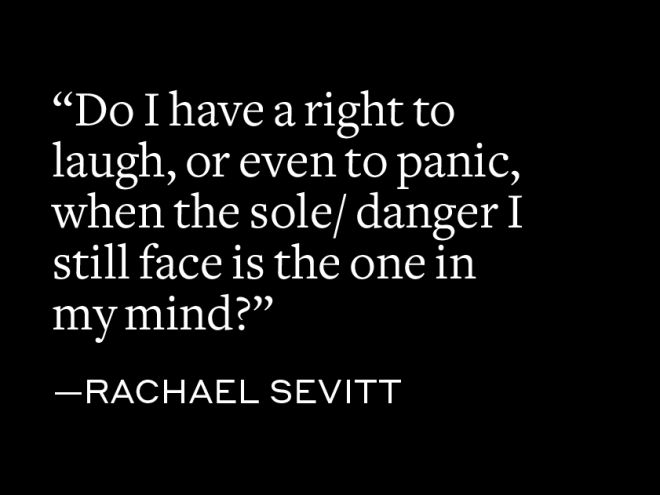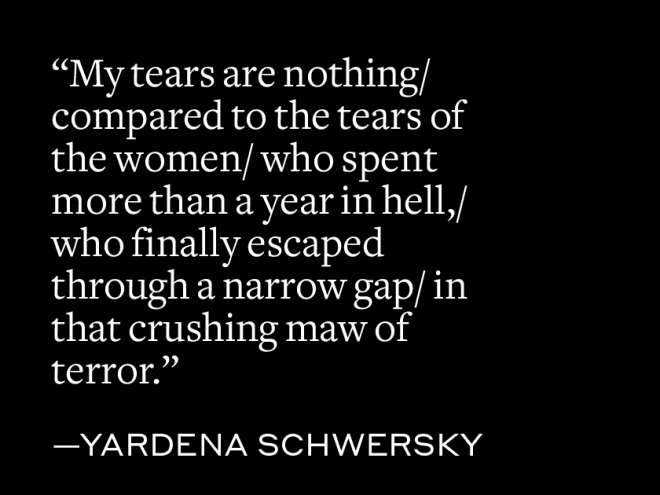
This piece is one of an ongoing series that we will be sharing in the coming days from Israeli authors and authors in Israel.
It is critical to understand history not just through the books that will be written later, but also through the first-hand testimonies and real-time accounting of events as they occur. At Jewish Book Council, we understand the value of these written testimonials and of sharing these individual experiences. It’s more important now than ever to give space to these voices and narratives.
In collaboration with the Jewish Book Council, JBI is recording writers’ first-hand accounts, as shared with and published by JBC, to increase the accessibility of these accounts for individuals who are blind, have low vision or are print disabled.
A fifteen-year-old girl enters her room and realizes that it’s gone. The walls are still present. Also, the wardrobe, the bed, and the table beside it. But her textbooks, notebooks, pencils, and pens, along with the personal diaries she wrote in each night, are missing. The contents of her drawers are gone, along with the treasured objects on her desk — photo albums, birthday cards, the collection of napkins. Except for her clothes, every personal item she had ever touched was gone and destroyed.
The girl I’m writing about is my mother in Israel in the 1950s. Her stepmother was a Holocaust survivor who witnessed her husband and two children disappear in the flames of the Auschwitz crematoria; she was a woman with post-traumatic stress who raised my mother out of the necessity of a second marriage and made my mother’s life hell. This woman threw out every personal belonging my mother owned. Many, many years passed before my mother forgave her stepmother, and heard her horrifying story, and ultimately took care of her in her old age with great compassion.
At the age of fifteen, in front of her empty room, my upright and vibrant mother feels that her world has fallen apart. She packs a suitcase and decides to leave.
She gets on a bus to the South and volunteers for the harvest with the “Hashomer HaTsa’ir” youth movement at Kibbutz Nir Oz. On her first day in the desert, with her face flushed from the sun and her hair tied back on the nape of her neck with a makeshift tie, her eyes met those of a short, blue-eyed boy. He belongs to the core of the kibbutz and is almost a decade older than her. Despite their age, they fall in love and get married.
Their “chuppah” is in a section of Kibbutz Nir Oz on the first days of its founding. Under a white sheet held by four guns, they stand barefoot on the desert sand.
My mother slept on my father’s chest on her wedding night and for years after. His stable body that was standing firmly on the land of the nascent kibbutz, became a part of her home. From then on, my parents are members of the kibbutz community and quickly found their home in the Negev. A future spread out under their feet and the soft sand of the desert. They were beautiful and young.
My father works on a tractor in the field during the day, and at night directs plays in the kibbutz theater. My mother cooks in the common room and sews clothes for the new members.
The kibbutz contains several members, all young and very Zionist, who live side by side, in the commune. They build modest buildings to suit all their needs, including a dining room, laundromat, administrative area, clinic, and clothing facility. Within a short period, my eldest sister is born on the land, the beginning of their larger family.
Less than 400 people lived in Kibbutz Nir Oz until October 7th 2023. More than a hundred of them were murdered or kidnapped by Hamas on the first day of the war. Hard truths are discovered every day, and from this new information it appears that no less than eighty members of the kibbutz were identified as missing. More than twenty-five of them were murdered in the massacre on Shabbat.
Among those killed were Haim, Oded, Clara, and Avner. People in their ninth decade of life and some of my parents’ best friends. They came to Israel as refugees from the Diaspora after the Holocaust — built and defended Israel, served in the Israel Defense Forces. They believed in Israel, and created a green, vibrant settlement in the heart of its desert. They were not the only ones who went through the inferno of Hamas. Next to them are – alive or as slaughtered bodies –babies, women, and children, people with special needs, cancer, and heart patients. All of them were torn from their homes early Saturday morning – wearing pajamas, their bodies warm from their bed sheets – and woke up to a nightmare. Those who were not kidnapped, raped, or killed in captivity – or going through horrific torture as I write these lines – were murdered in cold blood by Hamas.
Adi Negev, a close friend of my family, grew up in the kibbutz and lived there from the day it was founded. She shut herself in the protected area of her home when the massacre began and was miraculously saved from Hamas.When she got out, she was left alone in the mostly burned kibbutz.
“The army wants everyone to vacate, they will be more comfortable,” she says to me in frustration. “It will be possible to hide it. They will hide and bury it in their archives for fifty years. When I’m here, they can’t do that. There are things that need to be done and questions that need to be asked. In my community, it’s called tzmud. I’m not leaving.”
After going through three houses with the army to look for bodies, she broke down and was returned to her home. “You expect to find a man’s body, don’t you?” (She reported to The Hottest Place in Hell news website in real time.) “But you find much less than that. Everything burned here. There is nothing in the houses. It is an empty space. The fire was so huge that everything disappeared. But we must go through a house, to enter, we heard drilling in the process. I still don’t understand what happened here. You know what drives me crazy? The dogs are gone. Not the ones in uniform, the ones walking around outside. We had crowds.”
Adi carries with her a horrifying list that she prepared noting down the locations of bodies — in the vineyard, in the stable, in the houses, behind the clinic. And then a long list of those who are still missing. Some are just names. By many of them the word death is written.
Now, seventy-eight years after it was founded, eight days after it was destroyed – what do I remember from Kibbutz Nir Oz?
The old road that went up and down to the Negev and wound between desert ramps that made the stomach feel like an air pocket. The cotton flowers that preceded the yellow gate. The way the yellow gate would open so slowly. The times when we raced through in the white Subaru because there was no gate yet. The sunflower seeds that surrounded the fields. The three donkey swings – red, blue, yellow – in the playground. The iron locomotive that was placed on the hill for the kibbutz children, caked in carbon rust. The bloody fingers and the tetanus shots at the clinic. The small eyes of the animals that jumped over the fence. The gray kibbutz paths, which connected to each other in a wonderful maze, always returning to the starting point. The blue pool where I learned breaststroke. The picture of my mother in black and white, swimming across the pool in breaststroke. The rolls of thread in the sewing machine that were the size of my head. The agricultural water reservoir and the raft on it. The Shavuot combine that scattered colorful chewing gum among oat fragments on the children. The feeling of pride when a colorful, sweet, round ball hit me in the forehead. The smell of a pinecone after breaking it into pieces. My father, sitting on the tractor at night, changing his exiled surname to a new, Hebrew name, my surname. The fact that after my parents left the kibbutz, they continued to come. The fact that after my father died, my mother continued to come. The fact that after my mother died, I kept coming. The identifying look of the core members sitting in the dining room, which reminded me that here, in this place, I am still their daughter. The endless silence that stood above the meadows. The palms, the bushes, the aloe, the wildflowers. An oasis in which one could imagine an endless expanse of life.
The views and opinions expressed above are those of the author, based on their observations and experiences.
Support the work of Jewish Book Council and become a member today.
Sarai Shavit is a writer, poet, and a TV presenter. She has published two books of fiction and two poetry collections. Her award-winning poetry has been translated into German, English, French and Malayalam. She won the Tel Aviv Municipality Poetry Prize, the Goldberg Prize for Literature, and the Mifal Hapayis Poetry Prize.



